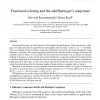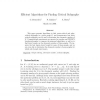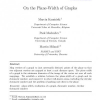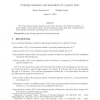70
Voted
COMBINATORICS
2006
15 years 14 days ago
2006
We prove the following extension of an old result of Andr
119
Voted
EJC
2008
15 years 15 days ago
2008
The adaptable chromatic number of a graph G is the smallest integer k such that for any edge k-colouring of G there exists a vertex kcolouring of G in which the same colour never ...
103
Voted
EJC
2008
15 years 15 days ago
2008
Gerards and Seymour (see [T.R. Jensen, B. Toft, Graph Coloring Problems, Wiley-Interscience, 1995], page 115) conjectured that if a graph has no odd complete minor of order p, the...
DM
2008
15 years 15 days ago
2008
For graphs G and H, let G H denote their Cartesian sum. This paper investigates the chromatic number and the circular chromatic number for GH. It is proved that (G H) max{ c(G)...
88
Voted
ENDM
2010
15 years 15 days ago
2010
A main result of combinatorial optimization is that clique and chromatic number of a perfect graph are computable in polynomial time (Gr
104
Voted
DAM
2008
15 years 15 days ago
2008
This paper presents algorithms to find vertex-critical and edgecritical subgraphs in a given graph G, and demonstrates how these critical subgraphs can be used to determine the ch...
100
Voted
DM
2010
15 years 16 days ago
2010
A labeling of a graph G is distinguishing if it is only preserved by the trivial automorphism of G. The distinguishing chromatic number of G is the smallest integer k such that G ...
95
Voted
CORR
2008
Springer
15 years 16 days ago
2008
Springer
Map vertices of a graph to (not necessarily distinct) points of the plane so that two adjacent vertices are mapped at least a unit distance apart. The plane-width of a graph is th...
110
Voted
CORR
2010
Springer
15 years 16 days ago
2010
Springer
We obtain improved upper bounds and new lower bounds on the chromatic number as a linear function of the clique number, for the intersection graphs (and their complements) of fini...
99
Voted
SODA
2000
ACM
15 years 1 months ago
2000
ACM
We give nontrivial bounds for the inductiveness or degeneracy of power graphs Gk of a planar graph G. This implies bounds for the chromatic number as well, since the inductiveness ...




